Endocrine system
Differentiate between paracrine, autocrine, endocrine, and neuroendocrine signaling when described or illustrated
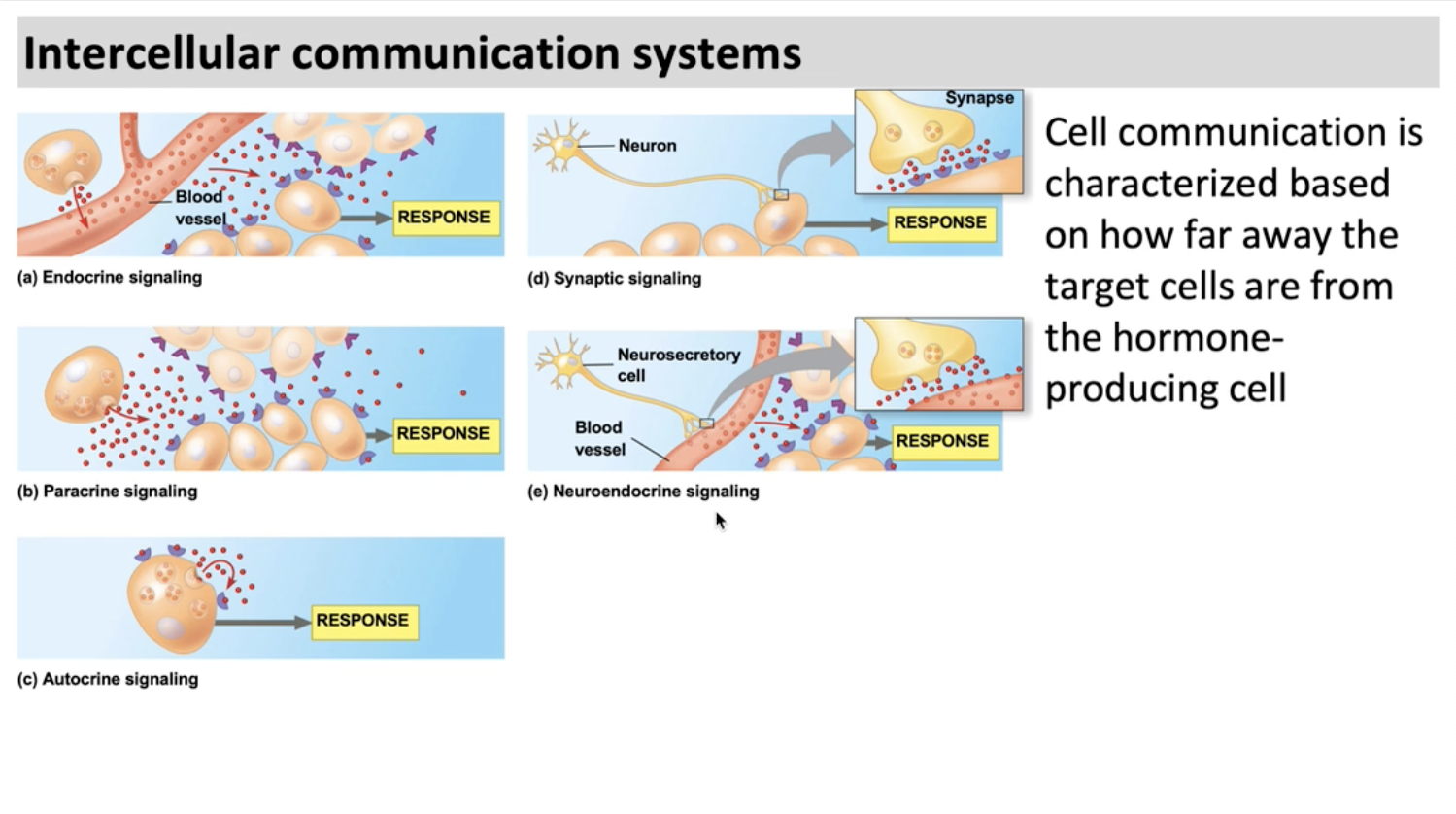
what is Endocrine signaling
a hormone that goes into the bloodstream and travel in some cases the entire length of the body to find its target cell
1/52
There's no tags or description
Looks like no tags are added yet.
Name | Mastery | Learn | Test | Matching | Spaced |
|---|
No study sessions yet.
53 Terms
Differentiate between paracrine, autocrine, endocrine, and neuroendocrine signaling when described or illustrated

what is Endocrine signaling
a hormone that goes into the bloodstream and travel in some cases the entire length of the body to find its target cell
what is paracrine signaling
when the endocrine cell is close by the target cell
True or false: Synaptic and neuroendocrine signaling are hormones that is produce and secreted by a neutron
True
synaptic signaling
close interaction between the target call and the cell producing the hormone, the target cell may be another neutron or a muscle cell.
Neuroendocrine signaling
the target cell is far away from the neuron, so the neuron secretes the hormone into the bloodstream, and the hormone travels some distance to find its targets
what is cytoplasmic response
hormone that binds to receptors on the cell membrane (or in the cytoplasm) which triggers a signal inside the cell, often through a signaling pathway
what is genomic response
a hormone that binds to receptors inside the cell (often nuclear receptors), which then act as transcription factors to activate or repress specific genes. This changes the production of protein in the cell.
Water soluble hormones includes
peptides, proteins, and monoamines
Amines
can be fat soluble depending on their structure and the presence of -NH2 functional group (this makes amine water soluble)
explain the function of eater soluble hormones
Releases by exocytosis, the cell that is making those hormones stores them in the vesicles that are membrane bound, When the cell is ready to excrete those hormones, that vesicles has to merge with the cell membrane to exocytose or release its contents. The hormones then go into the bloodstream and dissolve in the blood plasma (because it is water soluble).
Water soluble hormones do not have intracellular receptors because they’re not able to cross the plasma membrane, because the plasma membrane is made of fat and water cannot dissolve in lipids. Water soluble hormones attach to receptors outside of the cell, on the cell membrane, triggering a response inside the cell, without the hormone crossing the plasma membrane
Lipids soluble hormones include
steroids
explain how lipid soluble hormones work
The receptors on the target cell must be membrane bound because the water soluble hormone will not be able to cross the membrane. When the signal is received, either cytoplasmic response can be initiated or it can send a signal to nucleus to transcribe a gene to produce a protein.
They are released by diffusion, and they can cross the plasma membrane on their own. Once the lipid soluble hormones reach the blood plasma, they need to use a protein binding to help them stay within the blood because lipids cannot dissolve in blood.
Explain the consequences of hormone solubility in water in terms of hormone function
water soluble hormones travel easily in the bloodstream (since blood is mostly water), these hormones are effective for quick, short-term control of body processes (like fight or flight response).
Fat soluble hormones usually affect gene expression, turning specific genes on or off, which can take longer (hours to days). Because they can't travel easily in the bloodstream on their own, they often need a carrier protein to move through the body
Pancreas (endocrine gland) hormones
insulin and glucogon
chemical class: proteins
Insulin lowers blood glucose level
Glucagon raises blood glucose level
insulin ad glucagon is regulated by the glucose in the blood
adrenal glands and adrenal medualla hormones
epinephrine and norepinephrine
Epinephrine and norepinephrine
hormones produced by the adrenal glands, specifically from the adrenal medulla. They are derived from amino acids and play crucial roles in the body's stress response, promoting fight or flight reactions.
epinephrine and norepinephrine raise blood glucose level; increase metabolic activities; constrict certain blood vessels
they are regulated by the nervous system
chemical class: amine
insulin and glucagon
regulates glucose in blood and the chemical class are proteins
adrenal cortex ( gland) hormones
glucocorticoids and mineralocortioids
glucocorticoids and mineralocortioids chemical class
steriod
glucocorticoids
raises blood glucose levels and is regulated by ACTH
mineralocortioids
promates reabsorption of NA+ adn exceration of K+ in kidneys and is regulated by K+ in blood
gonads/ testes glands hormones
androgens
androgens
chemical class: steriods
support sprem formation’ promote development adn maintenance of male secondary sex characteristics
regulated by FSH and LH
ovaries gland hormones
estogens and progesterones
estrogens
chemical class: steriods
stimulates uterine lining growth; promotes development adn maintenance of female secondary sex characteristics
regulated by FSH and LH
progesteone
chemical class: steriods
promotes uterine lining growth
regulated by FSH and LH
hypothalamus gland hormones
hormones released by the posterior pituitary and homrones that regulate the anterior pituitary
pituitary gland hormones
oxytocin and antidiuretic
pituitary glands
posterior pituitary relases hormones made by the hypothalamus
oxytocin
chemical class: Peptide
stimulate contraction of uterus and mammary glands cells
Antidiuretic hromone (ADH)
chemcial class: peptides
promotes retention of water by kidneys
anterior pitutary hormones
growth hormone (GH), prolactin (PRL), Follicle stimulating hormone (FSH), Luteinizing hormone (LH), thyroid- stimulating hormone (TSH), and Adrenocortioctropic hromone (ACTH)
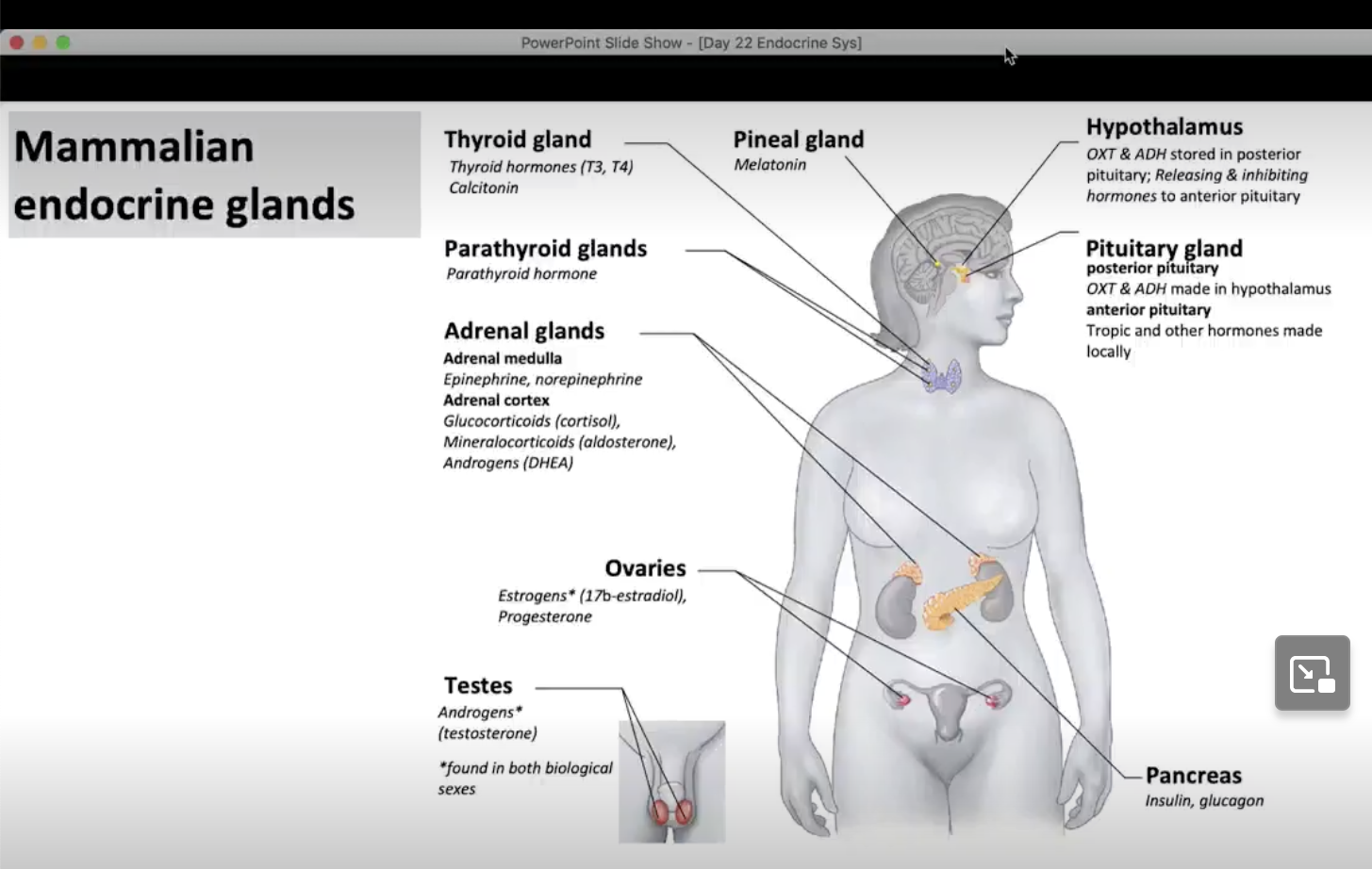
label the major tissues that secrete hormones on a diagram
pineal gland
melatonin
hypothamalmus
OXT and ADH stored in posterior pituitary relasing and inhbiting hormones to anterior pituitaary
pituitary gland
prolactin
posterior pituitary- OXT and ADH made in the hypothalamus
Anterior pituitary- Tropic and other hormones made locally
Pancreas
insulin and glucagon
testes
androgens- testosterone
found in both biological sexes
adrenal glands
Adrenal Medulla- epinephrine and noreponephrine
adrenal cortex- glucocorticoids (cortisol), mineralocorticoids (aldosterone), androgens (DHEA)
Parathyroid glands
parathyroid hormones
thyroid gland
thyroid hormones (T3,T4), calcitonin
draw and label a negative feedback loop for regulation of hormone levels and explain the general biological process regulated by such loops and give an example
The endocrine cell respond to low pH of food arriving from the stomach, the response cell is called S cells and they secrete secretin. The secretin travels in the bloodstream, reaches the pancreatic cells and makes bicarbonate to increase pH back to a normal range
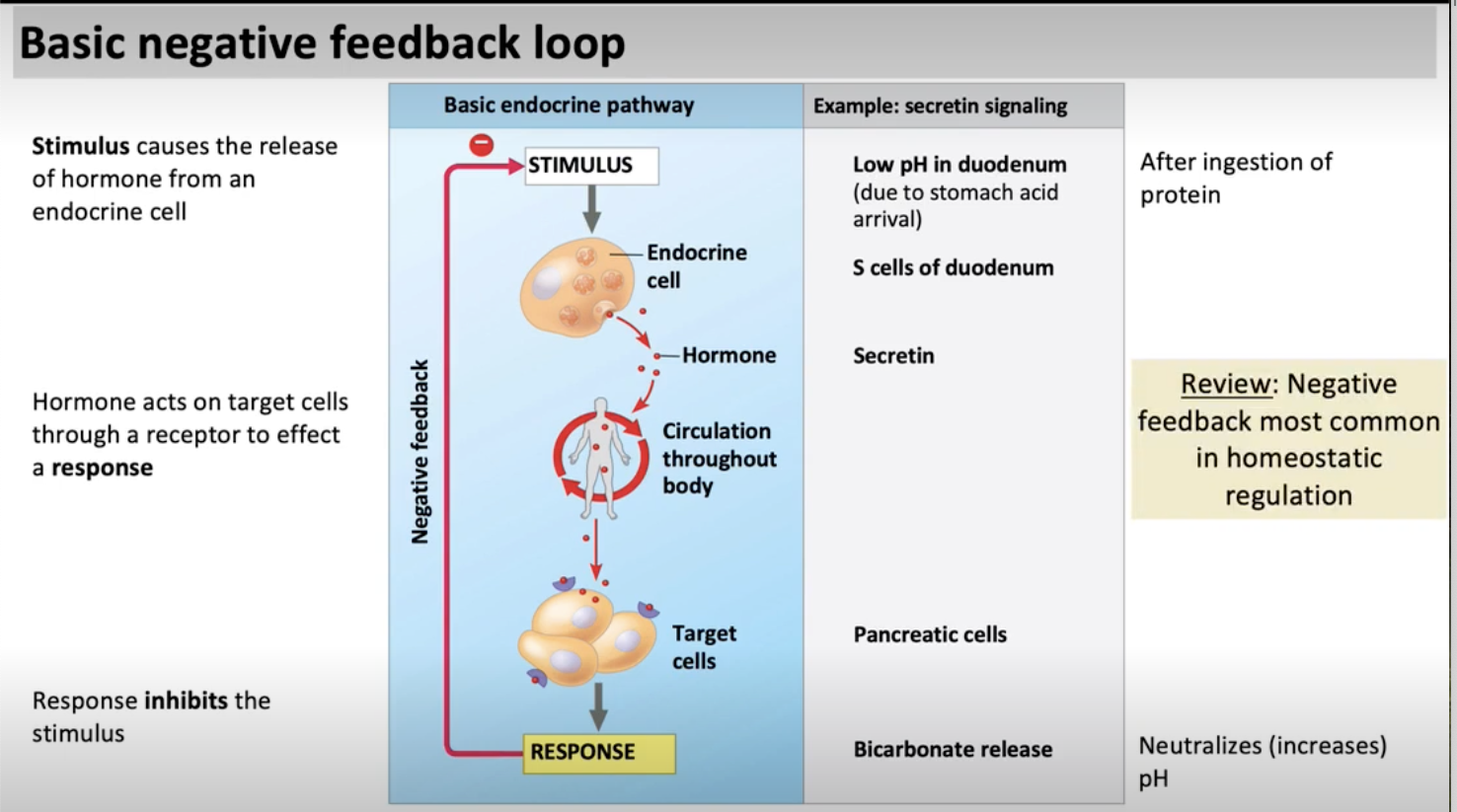
draw and label a positive feedback loop for regulation of hormone levels and explain the general biological process regulated by such loops and give an example
an action can trigger the hypothalamus to secrete a hormone in the posterior pituitary gland that enters the blood stream and then reaches target cells in the mammary glands and the response is milk production. Once that response is produced, there’s positive feedback to stimulate the hypothalamus to release more oxytocin from the posterior pituitary gland.
The posterior pituitary gland has neurons, the anterior pituitary gland does not.
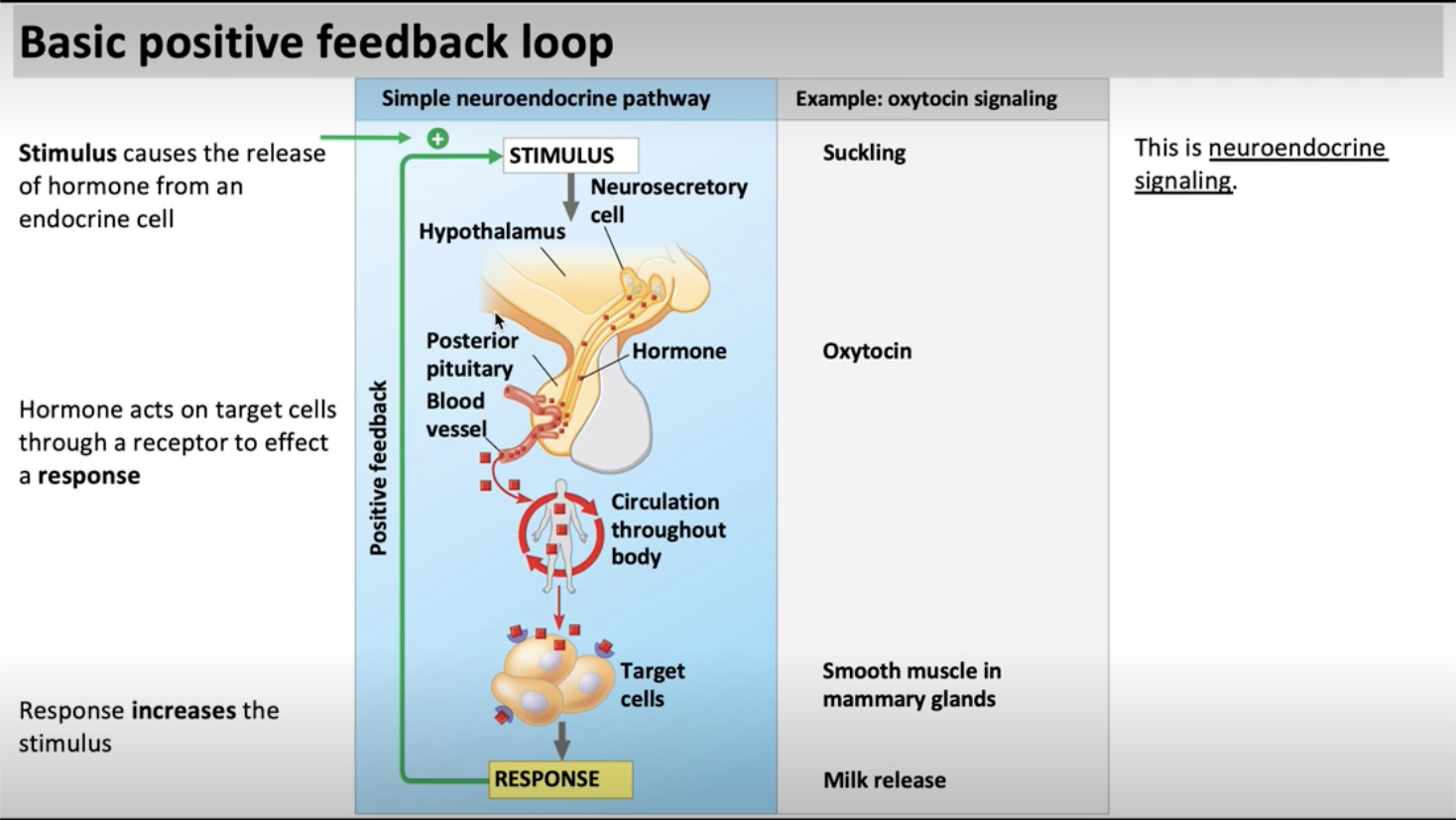
what is a negative feedback loop
the effect of a hormone reduced the further stimulation of its own release. An external stimulus tells an endocrine gland to produce a hormone; once the hormone reaches its target cell, the target cell will inhibit the endocrine gland from continuing to produce that hormone.
what is a positive feedback loop
the effect of a hormone that leads to increased stimulation for its release. The endocrine gland it stimulated to produce a hormone, the hormone reaches its target tissue, the product of the target tissue is going to enhance that endocrine gland further to make more hormones
Describe and label a general hypothalamus‐anterior pituitary‐target gland hormonal cascade
The hypothalamus releases hormones that stimulate the hypothalamus and inhibit the release of specific pituitary hormones. Some of these hormones act on the body directly. Other hormones are going to be involved in a cascade of signaling among different endocrine organs.
These hormones are called tropic because they stimulate the secretion of other hormones rather than acting on the body directly.
Prolactin is an example of a hormone that acts on the body directly.
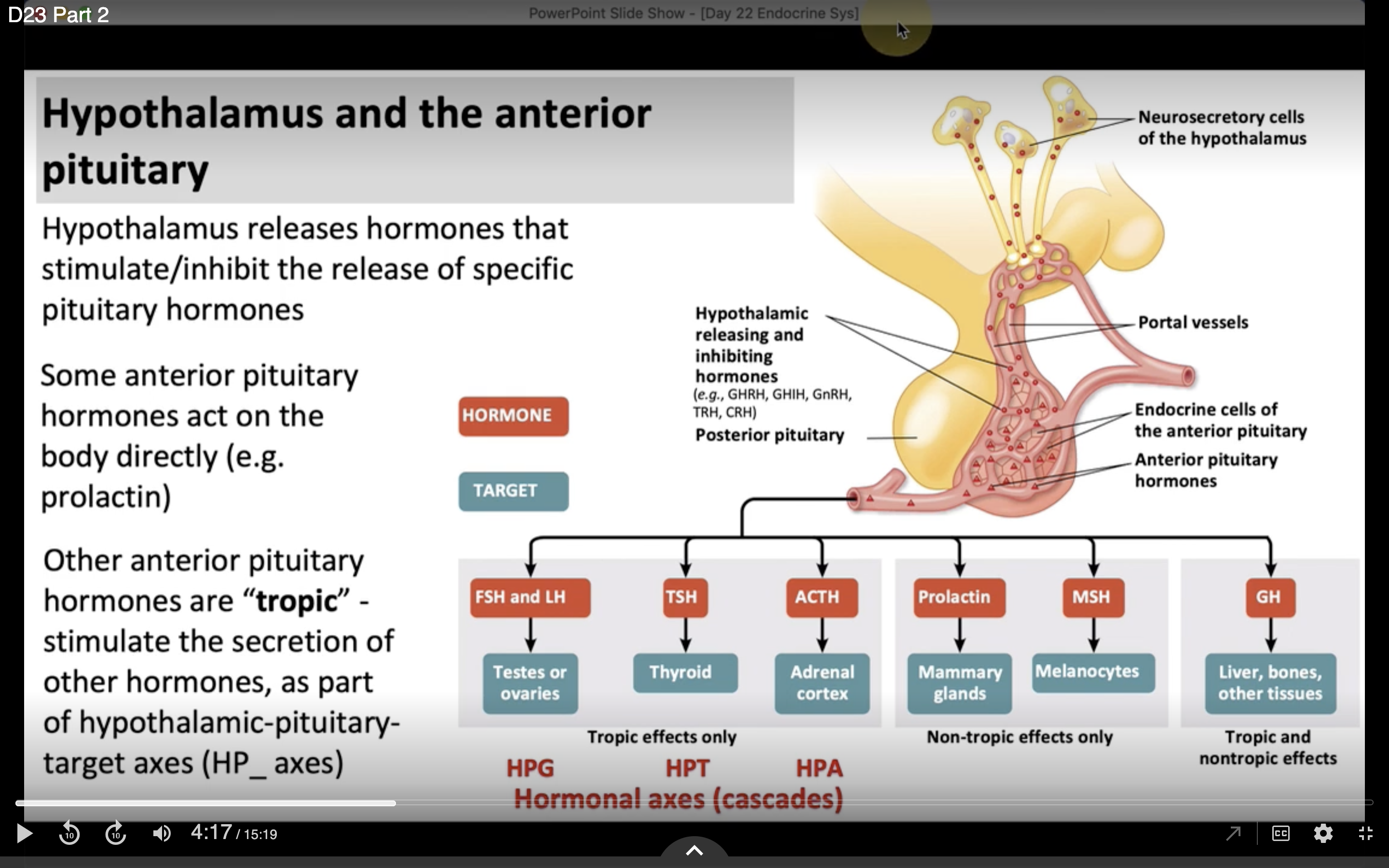
Explain the role of hormone receptors in regulating hormone functions, and how variation in receptors and tissues can lead to different responses to the same hormone
If the liver cell receives epinephrine that has a beta receptor on the surface of it it will trigger glycogen deposit to transform into glucose and be secreted.
If a muscle cell receives epinephrine with a beta receptor, the muscle cell will be triggered to relax and the blood vessel will dilate, increasing flow to the skeletal muscle.
If a muscle cell receives epinephrine with an alpha receptor, the muscle will contract and the blood vessel with constrict, decreasing flow to the intestines.
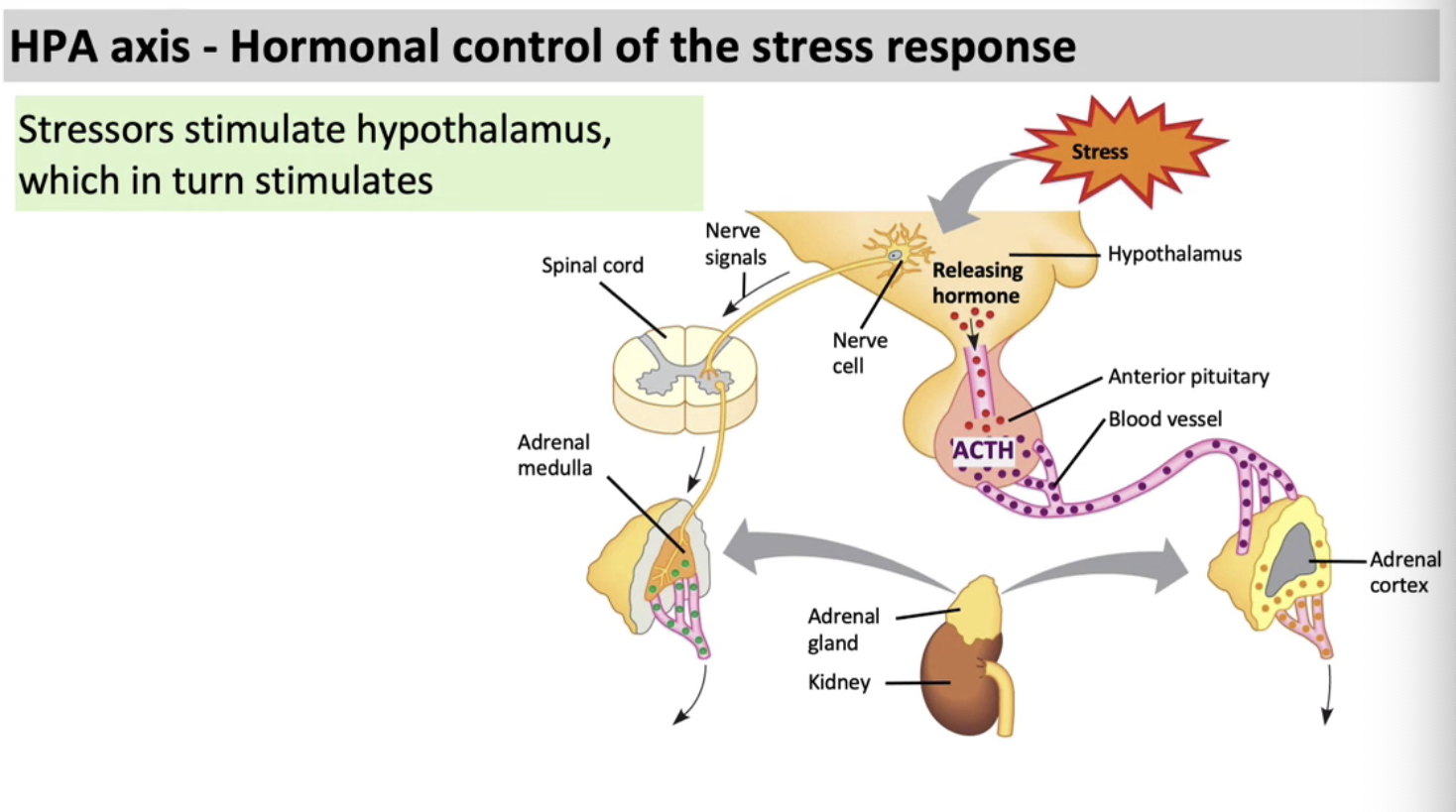
Illustrate the function, significance, and control of the Hypothalamic‐Pituitary‐Adrenal (HPA) Axis.
Involves the adrenal gland which secretes stress hormones.
A stressor (like a rollercoaster) stimulates the hypothalamus, anf that hyptothalamus stimulates the secretion of epinephrine directly.
The nerve signal travels through the spinal cord to the adrenal medually and that adrenal meduall is then going to secrete epinephrine.
Indirectly, the HPA at the hptohtamlus will stimulates the ACTH from the anterior pitutiatary. ACTH travel through the bloodstream to reach the adrenal cortex, the cortex secretes cortisol. HPA axis included the methods that goes pass the pituitary glands (ACTH) such as the hypothalamus, anterior pituitary, blood vessel, adrenal cortex, and cortisol.
Adrenal medulla, spinal cord, nerve signals, and epinephrine goes to the adrenal gland and not the anterior pituitary.
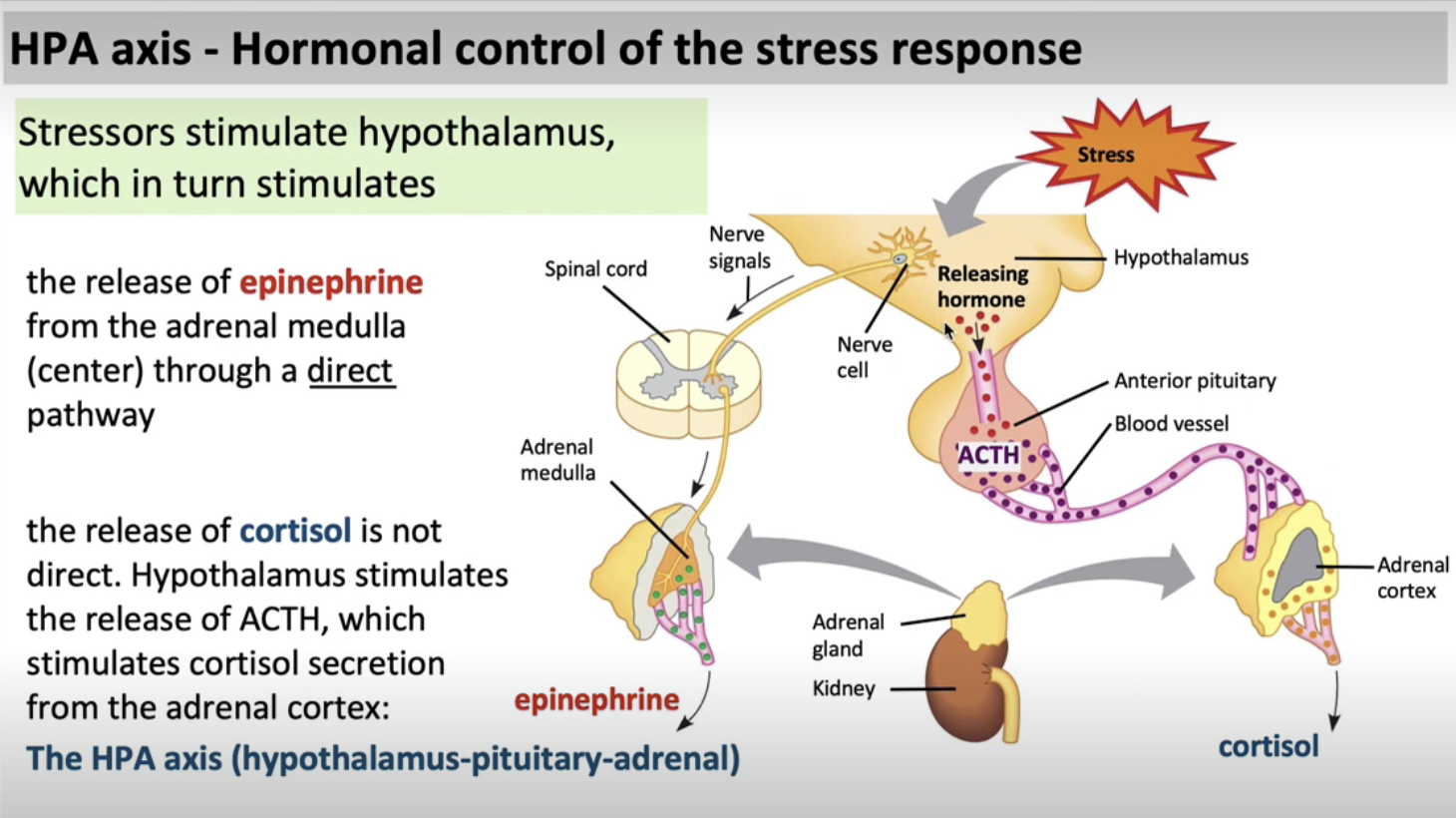
What is an example of negative feedback homorone secretion? Why does it happen? Why does the product inhibit the endocrine gland from producing a hormone?
When the hormone (the product) reaches a certain level, the body doesn’t want to overproduce it because too much of the hormone can have harmful effects. So, the high levels of the hormone send a signal to the gland to stop producing more, keeping things in balance.
effects of epinephrine and norepinephrne
glycogen broken down to glucose, increases blood glucose
increases blood pressure
increased breathing rate
increased metabolic rate
change in blood flow patterns, leading to increased alertness and decreased digestive, excretory, and reproductive system activity
effects of mineralcorticoids
retention of sodium ions and water by kidneys
increased blood volumes and blood pressure
effects of glucocorticoids
protein and fats broken down and converted to glucose, leading to increased blood glucose
partial suppression of immune system
redirection of energy to survive